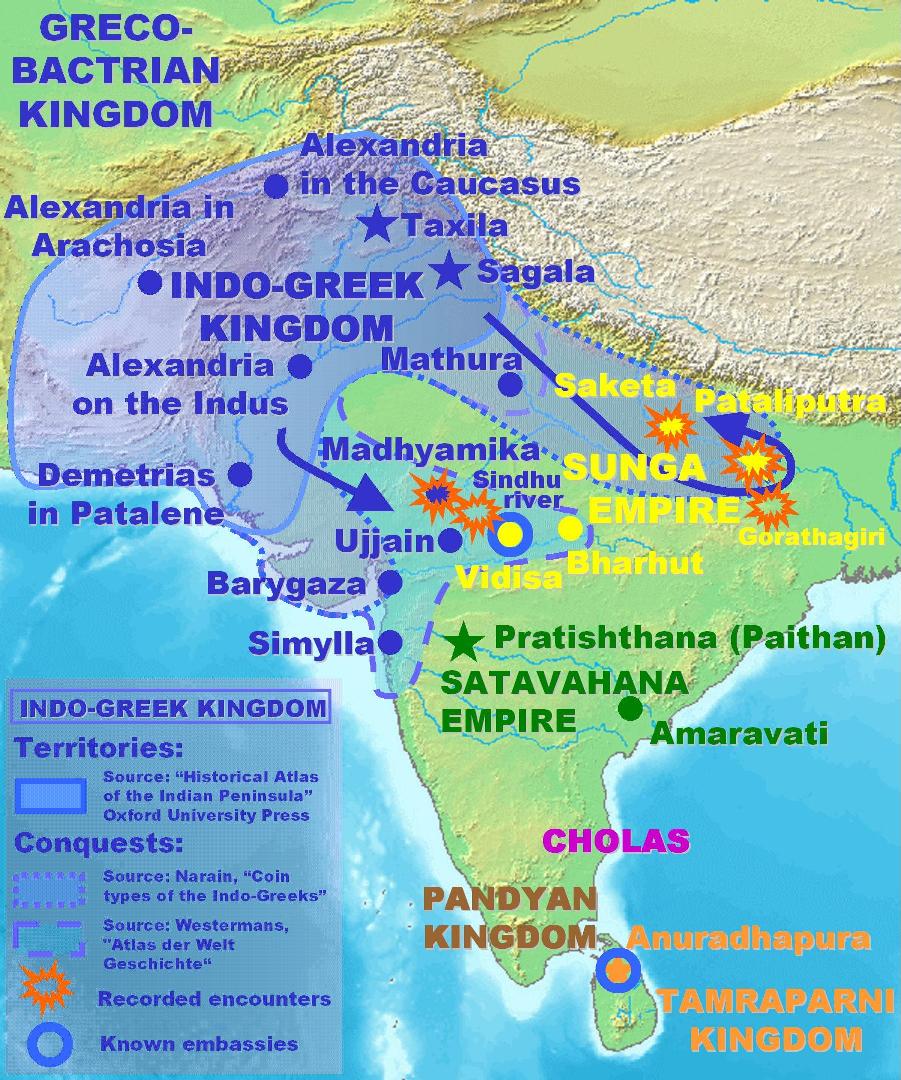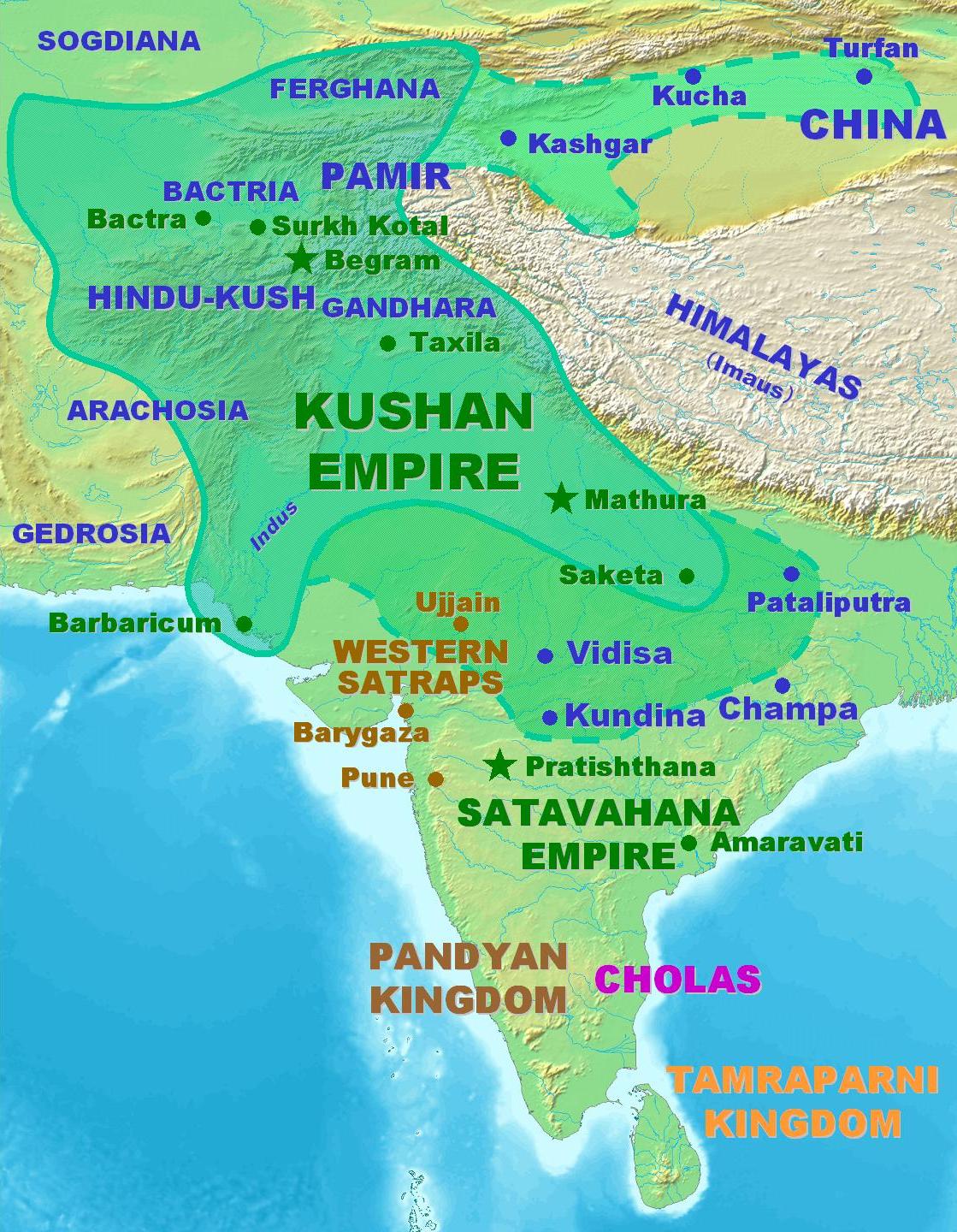As we have discussed that Pushyamitra Sunga (185 B.C.-149 B.C.) the general of last Mauryan king Brihadratha, killed him. After that he captured the region of Magadha from the Mauryans and established the Sunga Dynasty, his region was extended upto Sialkot in north west. However, the dynasty of Sungas didn't ruled very long. Pushyamitra was succeeded by his son Agnimitra Sunga (149 B.C.-141 B.C.), who ruled for 8 years. Agnimitra was succeeded by his son Vasujyestha and he was followed by his half brother Vasumitra who ruled from 131 B.C.-124 B.C. Vasumitra was credited with the successful repelling of Yavanas (Indo-Greek). The last ruler of Sunga Dynasty was Devabhuti, who was killed by his Minister Vasudeva Kanva in 73 B.C., later Vasudeva Kanva established the rule of Kanva Dynasty, who according to some sources lasted for only 45 years. This dynasty was brought to an end by Satavahana dynasty.
Meanwhile, after the end of Seleucid empire, Greek rule of north west was prevalent in two provinces, Parthia and Bactria. Menander(reigned from 165 B.C.-145 B.C.), A Bactrian king stretched his kingdom towards west and penetrated into the Ganga-Yamuna Doab region. He made Sakala (now, Sialkot) his capital. As per Buddhist texts, as he was a Buddhist, he was referred to as 'Milinda'. Gold coins were issued by Indo-Greek for the first time in India. Art under Indo-Greek also flourished in the Gandhara region, & was known as Hellenistic art.
The flourishing reign of Indo-Greeks came to an end by the attacks of a tribe of Central Asia, known as the Sakas. Sakas didn't faced any resistance from India, as there wasn't any powerful Indian king or kingdom.
They established their kingdom almost throughout the India. Their conflict with satavahanas ended when Satavahana king, Gautamiputra Satakarni (78 C.E.-102 C.E.) defeated Saka king Nahapana. However, Rudradaman, the greatest Saka king tried to recover the regions the sakas had lost earlier to satavahanas & later succeeded. Rudradaman was a good administrator. He reigned from 130 C.E. to 150 C.E.
During the reign of Sakas and Satavahanas there was also tribe named, Yue-chi controlled the area of modern day eastern Afghanistan and parts of Pakistan. The major clan of this tribe was the Kushana clan, they dominated the area of Indus valley. Greatest among the rulers of Kushana clan was Kanishka, who ruled from A.D. 78 to A.D. 101. Kanishka, started a new era called, Saka era from the year A.D. 78. He said to have convened the fourth buddhist council in Kashmir or Jalandhar. Under his reign, Kushanas controlled the great Silk Route. The successors of Kanishka were weak rulers and later the reign of Kushanas came to an end after its conquest by Sassanid empire.
This was the story of the Post-mauryan period. Many dynasty came and all of them went on one after another, none of them had the capacity of holding India together for many years like Mauryans did. But, The prosperity of India didn't end after the Mauryans actually it started after the end of 3rd century, The age of history makers, also referred by many historians as the 'Golden Age of India', the dynasty known as 'The Gupta Empire' emerged as the leading power in India under the leadership of Chandra Gupta I. We will know more about them in the Next post.
Indo-Greek Campaigns
The flourishing reign of Indo-Greeks came to an end by the attacks of a tribe of Central Asia, known as the Sakas. Sakas didn't faced any resistance from India, as there wasn't any powerful Indian king or kingdom.
They established their kingdom almost throughout the India. Their conflict with satavahanas ended when Satavahana king, Gautamiputra Satakarni (78 C.E.-102 C.E.) defeated Saka king Nahapana. However, Rudradaman, the greatest Saka king tried to recover the regions the sakas had lost earlier to satavahanas & later succeeded. Rudradaman was a good administrator. He reigned from 130 C.E. to 150 C.E.
During the reign of Sakas and Satavahanas there was also tribe named, Yue-chi controlled the area of modern day eastern Afghanistan and parts of Pakistan. The major clan of this tribe was the Kushana clan, they dominated the area of Indus valley. Greatest among the rulers of Kushana clan was Kanishka, who ruled from A.D. 78 to A.D. 101. Kanishka, started a new era called, Saka era from the year A.D. 78. He said to have convened the fourth buddhist council in Kashmir or Jalandhar. Under his reign, Kushanas controlled the great Silk Route. The successors of Kanishka were weak rulers and later the reign of Kushanas came to an end after its conquest by Sassanid empire.
Kushana Empire Under Kanishka
This was the story of the Post-mauryan period. Many dynasty came and all of them went on one after another, none of them had the capacity of holding India together for many years like Mauryans did. But, The prosperity of India didn't end after the Mauryans actually it started after the end of 3rd century, The age of history makers, also referred by many historians as the 'Golden Age of India', the dynasty known as 'The Gupta Empire' emerged as the leading power in India under the leadership of Chandra Gupta I. We will know more about them in the Next post.













